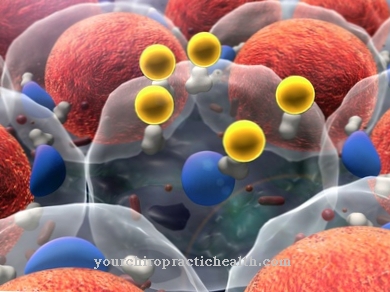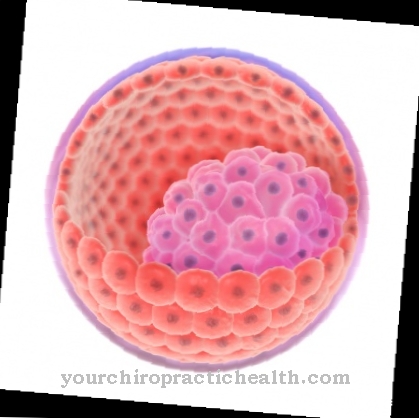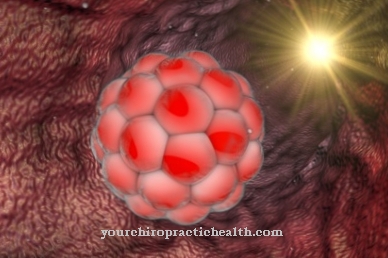The Inheritance is responsible for making children look like their relatives. As part of complex processes, various properties are passed on to descendants via the chromosomes. Thereby, mother and father always meet two characteristics for each characteristic.
What is inheritance

Humans have 46 chromosomes. Chromosomes are the carriers of DNA on which all information for physical appearances is stored. For example, they decide which eye color will develop or what size the offspring will reach.
There are 46 chromosomes in every cell in the body, excluding the germ cells, which divide during meiosis. The diploid set of chromosomes comes in equal parts from mother and father.
Chromosomes are the starting point of inheritance. There are various rules and properties according to which characteristics are inherited. The main reason for the great genetic diversity in a population is the recombination of the alleles. Alleles are individual components of chromosomes. In this way, in the long term, evolution can take place at the same time as soon as adaptation to new living conditions becomes necessary.
Function & task
It has long been known that children often look very similar to their parents. How such a phenomenon comes about was only gradually deciphered by Gregor Johann Mendel in 1865. He carried out experiments with peas and was able to name processes according to which characteristics of plants are passed on.
However, these regularities cannot be transferred one-to-one to humans. Instead, it is a far more complex process. In total, there are around 25,000 genes in human chromosomes. These ultimately determine the appearance and the course of metabolic processes. The genetic variance is almost infinite. There are a total of around 64 trillion possible combinations, which ultimately ensure that people are similar but still differ from one another.
Ultimately, inheritance ensures that there are two blueprints (from mother and father) for all characteristics in each cell. Which version will prevail is decided very early on. This leads to the fact that certain traits are inherited dominantly, while others remain recessive.
An influence on which phenomenon prevails cannot be exercised. The parents carry recessive genes that can develop into a dominant gene through inheritance. For example, it is possible that mother and father have black and blonde hair. As a rule, black hair is inherited dominantly.
However, the mother may just as well carry a gene for blonde hair, which, although it did not prevail in her, may now combine with the same gene from the father, which ultimately results in the offspring also having blonde hair. Due to the existing, but undefined, inherited genes that are ultimately retrieved from the descendants, it is also possible for grandchildren to look like their grandparents or more distant relatives.
Ultimately, every person has genes within them that could not prevail in their own appearance. It is still possible to inherit these characteristics. The most important task of inheritance is therefore the creation of genetic diversity. This is also of great importance for evolution.
Illnesses & ailments
Diseases can occur as part of inheritance. There are various hereditary diseases that are passed on according to certain patterns. For example, albinism, cretinism and Peters-Plus-Syndrome are inherited as an autosomal recessive trait.
The starting point here is again the chromosomes. In autosomal inheritance, the defective gene is on one of the chromosomes that are not responsible for determining sex. However, for the disease to prevail and be passed on to offspring, both parents must have the damaged gene. This is the only way to get sick. However, it is not necessary that the parents actively suffer from the disease. Instead, they can also be carriers, in that the property has not prevailed in them, but it is still present in the genome.
In the case of autosomal dominant diseases, however, the presence of a defective gene is sufficient to trigger the disease. Thus, the child's risk of illness is 50 percent. Diseases with an autosomal dominant inheritance include sickle cell anemia and Marfan's syndrome, for example.
In addition to autosomal inheritance patterns, there are also those that are transmitted via the gonosome. For example, there are genes on the X chromosome that trigger hemophilia or red-green blindness. Women have two X chromosomes, men one X and one Y chromosome. In the case of an X-linked inheritance, the gender of the parents and the child is decisive. For example, if a man carries a defective gene on his X gonosome, all of his daughters will be carriers of the disease despite a healthy mother.
This is based on the fact that children receive one X chromosome from their father and one from their mother in order to develop their gender. If the woman also has the defective gene, all of the offspring will have the expression for a certain disease. If only the woman is affected, her sons become ill, while her daughters are carriers. If carriers get children, they will be carriers, healthy or sick in equal parts.













.jpg)

.jpg)
.jpg)











.jpg)